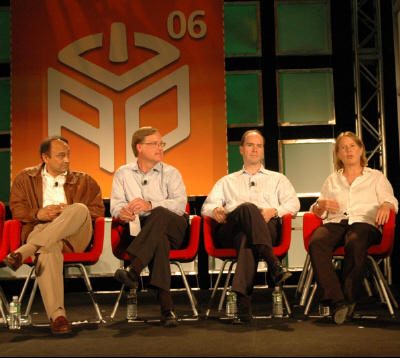AlwaysOn: Virtualization re-inventing the data center

Virtualization, along with SOA, multi-core processors and other technologies, is changing the economics of data centers. "It's the biggest thing going on it IT," said Diane Greene, president and founder of virtualization pioneer VMware during a panel at the AlwaysOn Stanford Summit. "It's front and center in the mind of CIOs because they can do a lot more with less."
She gave a number of 27 million servers humming in data centers, and said how virtualization can lead to significant savings in power, cooling and space, and improved security. "It's the most non-disruptive, disruptive technology," she said, referring to the simplicity of virtualizing an environment.
Much of the discussion, led by Andy Rachleff, a partner at Benchmark Capital, was at the virtualization 101 level. What is it, how does it work, what are the challenges, how will virtualization affect processor and storage vendors, as well as licensing schemes. Other panelists included Jeff Palmer, CEO of Blue Lane Technologies; Atiq Raza, CEO of Raza Microelectronics; and Ben Horowitz, CEO of Opsware.

Atiq Raza, CEO of Raza Microelectronics; Jeff Palmer, CEO of Blue Lane Technologies; Ben Horowitz, CEO of Opsware; and Diane Greene, president of VMware
In response to an audience question, VMware's Greene brought up the profound change that is coming to virtualized environments. "Operating systems statically configured on hardware are hard to manage and can be bug prone," Greene said. "If you bring in a hypervisor and break the paths [operating systems glued to hardware] apart, the hypervisor manages the hardware and the operating system manages the applications. People will have operating systems tailored to the applications, such as if more security is required. We have ISVs building their own operating systems, and application designers will build own operations systems."
Horowitz said that if you go for creating lots of virtual machines and software stacks, it can be a management challenge. "More of anything, including virtual machines, is more complicated, but it tastes great," he said. In addition, management software has to evolve to adapt to virtualization. Raza brought up that the hardware is trying to keep up with demands set by the software vendors. "That will change in the next three to five years," Raza said. He also noted that virtualization is impacting network architecture. "There is a need for application- and service-oriented networking--multiple servers, management and networking are converging all in on a single platform."
The subject of Microsoft came up. Microsoft competes with VMware, and Greene gave her point of view on what the industry needs to do to avoid repeating the past, exemplified by multiple, incompatible implementations. "The industry goes at Microsoft's cadence. The data center has to change [when Microsoft has new software]. This is a phenomenal opportunity for the industry. To that end VMware is progressive and pushing standards, so you can run any hypervisor with any operating system with any system management or any virtual machine," Greene said. "If the industry pushes this adoption, [the competition] will be about price and quality. Time will tell if Microsoft will get on with the standard. Things happen very fast with communications, the Web and blogging. When people recognize the opportunity in pushing the standard, I don't know why they wouldn't get behind it."
Greene also said that virtualization is impacting cultural issues in IT shops. "A data center is organized by the vendors they have right now, but as people operationalize virtualized infrastructure, a big change is going on." Development, testing and production can all use the same infrastructure, breaking down barriers among different groups in the solution chain.
At risk in the new world of virtualization are some of the established players. "Anytime there is a fundamental technology shift, whoever was a dominant player in the old paradigm run risk of losing. It goes across operating systems, management vendors and hardware providers," Horowitz said. "I am always into the win-win," Greene said. "Microsoft and x86 environment is commodity system. It's a big win for the customer, drawing it in to run the data center. It could be a win for Microsoft and the entire ecosystem."
The IT buyer is ultimate winner, said Palmer. "Pick the pieces you want and change on your own schedule."